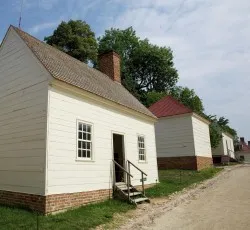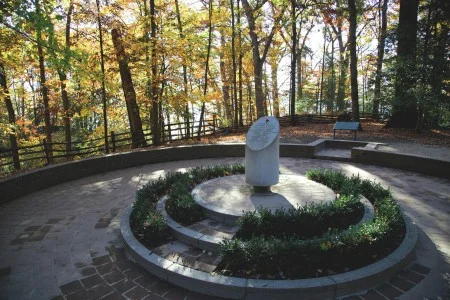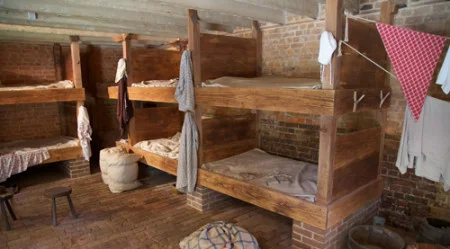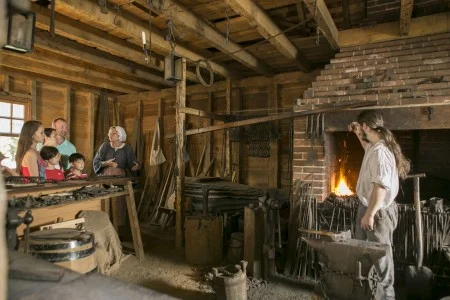In 1799, George Washington's estate was home to a community of 317 enslaved men, women, and children. Visit Mount Vernon, located just outside of Washington, D.C., to learn about the community and culture of the enslaved people who lived and worked here.

At the Ford Orientation Center
Take an audio tour to learn about the estate's history as you walk the grounds.
Look for the self-guided tour map about the Enslaved People of Mount Vernon at the Guest Services Desk.

Lives Bound Together: Slavery at Mount Vernon Exhibit
Explore the lives of the enslaved people at Mount Vernon at this in-depth exhibit, included with admission.
Within the quarters of the historic area, learn about the 317 enslaved people who lived and worked at George Washington’s five farms, gristmill, and distillery. Find out how enslaved people formed families, created tight-knit communities, earned money, and acquired personal possessions.
Learn More
The Enslaved People of Mount Vernon Tour
During this 60-minute guided walking tour, learn about the daily lives of the enslaved community who built and operated Mount Vernon.
This tour is included with admission. A free tour ticket is required.
Offered daily from February – December
Learn More
Wreath Laying at the Slave Memorial
Commemorate the enslaved community at Mount Vernon during our special wreath-laying presentations.
Offered daily from February – October
Learn More
Story of an American Icon Exhibit
Visit the Mount Vernon: Story of an American Icon in the Museum and learn about the different people who shaped Mount Vernon, including the formerly enslaved individuals who helped preserve and interpret George Washington’s home.
Open daily
Learn More
Distillery and Gristmill Tour
Tour the Distillery and Gristmill and learn about how enslaved distillers Hanson, Peter, Nat, Daniel, James, and Timothy performed the hot and tiring work of making whiskey.
Admission to the Distillery and Gristmill is included with admission to Mount Vernon, or can be purchased separately for those only visiting the Distillery and Gristmill.
Offered weekends from 10 a.m. to 5 p.m., April – October
Learn More
Walk the Estate Grounds
The locations below were all central to daily operations on the estate. Visit each to learn more.

The Kitchen
Explore the interior of George Washington’s 18th-century Mansion and kitchen. A staff of enslaved butlers, housemaids, waiters, and cooks made the Washingtons’ lifestyle possible.
Entry to the Mansion is by guided tour only. We recommend reserving a ticket in advance online to receive your desired tour time. A $2 fee per person will apply.
Learn MoreOn the Estate
Slave Memorial & African American Burial Ground
This memorial marks the site where enslaved people were buried in the 18th and 19th centuries, usually without identifying markers.
In 2014, Mount Vernon's archaeologists began a multi-year project to create a map showing where individuals are interred on the ridge just southwest of Washington’s tomb. This work documents the location of each grave, and will not excavate any remains buried in the burial ground.
Kitchen
Tour the kitchen where enslaved cooks such as Doll, Hercules, Lucy, and Nathan, worked from 4 a.m. to late in the evening to prepare meals for the Washington Family and their many guests.
Learn about the complex process of 18th-century cooking and the lives of the enslaved individuals who contributed to Mount Vernon’s reputation for hospitality.
Slave Quarters
View the reconstructed Women's and Men's bunkrooms of the Greenhouse Slave Quarters, a space that housed many of the enslaved people who worked on Mansion House Farm.
Reproduction clothing, tools, furniture, cookware, ceramics, toys, and personal accessories help depict enslaved people's living conditions and experiences.
Blacksmith Shop
Visit the reconstructed blacksmith shop located on the site where enslaved blacksmiths Nat and George completed work that was essential to the running of Mount Vernon.
Chat with history interpreters to learn more about the blacksmithing trade and the lives of enslaved craftsmen.
Wash House
In the wash house, Dolsey, Vina, and other enslaved laundresses worked up to six days a week washing and drying clothes for the Washingtons, their guests, and Mount Vernon’s hired white workers.
Coach House and Stables
Learn about how enslaved men and boys, such as Peter Hardiman, were responsible for caring for and breeding Mount Vernon’s 21 horses at the coach house and stables.
The Farm
The Farm offers visitors a chance to learn more about the lives of the enslaved individuals who put Washington’s agrarian ideas into practice.
Observe historic trades interpreters as they demonstrate many of the skills that would have been performed by those assigned work at one of the outlying farms like hoeing fields, harvesting crops, or threshing wheat.
Slave Cabin
The replica cabin allows you to see the living conditions of many of the enslaved families who lived and worked on George Washington’s outlying farms. On each farm, several cabins would be built in a cluster near the overseer’s house.
Mount Vernon: The Making of an American Icon
Visit the Story of an American Icon museum exhibit and learn about the different people who shaped Mount Vernon, including the formerly enslaved individuals who helped the Mount Vernon Ladies' Association preserve and interpret George Washington’s home.
Open weekends from 10 a.m. to 5 p.m., April through October
Take a tour of the Distillery and Gristmill and learn about how enslaved distillers Hanson, Peter, Nat, Daniel, James, and Timothy performed the hot and tiring work of making whiskey.
In addition to being one of the largest whiskey distilleries in America in 1799, the distillery and gristmill were the central hub for the enslaved community living and working on George Washington’s Dougue Run farm.
Admission to the Distillery and Gristmill is included with admission to Mount Vernon, or can be purchased separately for those only visiting the Distillery and Gristmill.
Extend Your Visit Online
Learn more about the lives of those enslaved at Mount Vernon and Washington’s changing views on slavery.
Estate Hours
Mount Vernon is open 365 days a year, including holidays.
April through October: 9 a.m. - 5 p.m.*
November through March: 9 a.m. - 4 p.m.*
*The museum is open to guests for 30 minutes after closing. The Education Center is closed for an extensive rebuild and will reopen in 2026.
Estate Admission
George Washington's estate is a can’t-miss for history buffs, families, and visitors to Washington, D.C.
Start by getting your grounds pass, which grants you admission to the estate. Plus, get unlimited visits in 2025 for the price of one.
Starting at:
$28 Adults (12+)
$15 Youth (6-11)
FREE Children (0-5)
Estate Directions & Transportation
Mount Vernon is located just outside of Washington, D.C., and is easily accessible by car. Parking is free.
You can also reach us by public transportation, via boat cruise, or by bike (bike rentals are available).
Our street address:
3200 Mount Vernon Memorial Highway
Mount Vernon, VA 22121
Accessibility Information
George Washington's Mount Vernon is committed to providing exceptional customer service to all guests who visit us. Get an overview of the many services and accessibility options available at Mount Vernon.
Extend Your Visit Online
Learn more about the lives of those enslaved at Mount Vernon and Washington’s changing views on slavery.
Learn moreLives Bound Together Online
Lives Bound Together: Slavery at George Washington's Mount Vernon was an exhibit on display from the fall of 2016 to the summer of 2021.
You can tour the exhibit virtually below.
Lives Bound Together: Slavery at George Washington's Mount Vernon
This exhibit was on display from the fall of 2016 to the summer of 2021. Tour the exhibit virtually below.
Researching Slavery
To piece together the stories of Mount Vernon’s enslaved community, historians studied George Washington's papers, archeological evidence of
combined with archaeology and oral history with descendants, to












